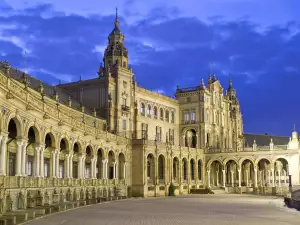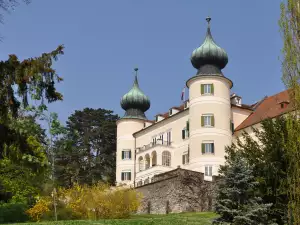Seville

Seville is one of the most attractive cities in Spain. There for most of the year life is "flashing" with burning rhythms of flamenco and numerous festivals. Deserving their fair fame of the resort town, Seville welcomes tourists constantly from around the world who come to this part of Spain to experience the atmosphere of this opulent Spanish city that seems to refuse to enter into the modern and hectic pace, which has spread into most major cities. The priority there is calm with carefree dancing and capricious manner which is characteristic for the Spaniards.
Seville is the fourth largest city in Spain. It is situated in the south of the country and is a major center of the autonomous region of Andalusia and the province of Seville. In the southern Spanish village the river Guadalquivir crosses, which is another plus to the pleasant atmosphere in Seville. The whole city is an area of 140 sq. km, and its population is approximately 700 000 people. The number of residents in the urban agglomeration of Seville is approximately, half a million people. Seville is also known by the name, City of orange trees.
The history of Seville began over 2000 years ago between the 8th or 9th century BC. As part of the Roman Empire, Seville is known as Hispalis, a little further in time its name was transformed by the Moors. Only with the arrival of the Spanish the town then gets the final name Seville. Although the town is situated 87 km from the estuary of the Guadalquivir, it is only 7 meters in altitude, in the past it was possible for marine vessels to stop there. In 16th -17th century, Seville was the main port through which passed the links between Spain and its overseas colonial empire.

The burning epidemic plague, known as the Great Plague because of the huge number of victims, in 1649 led to the death of almost half the population of Seville. This great tragedy was such huge damage to the city that it failed to recover until 1800. In the 19th and 20th century the population of Seville began to grow and an increase in the industry of the city was evident.
Seville is the former Moorish capital and this is seen as a consequence of today as the Mauritian and Christian mixed style of architecture in the city, has proven a unique charm. Here, next to the Gothic cathedrals you can see the lavish detail, typical of the Islamic architecture. That mixed architectural style bears the name Mudejar, and provoked a boom in construction of buildings in a similar model between the 12th and 14th century. One of the biggest attractions of Seville is the Alcazar Castle, which is a good example when it comes to Muslim-Christian architecture.
Another remarkable building is the cathedral of Seville. This large and impressive gothic church was built between the years 1401-1519 on the ruins of an earlier mosque on the site. The Cathedral of Seville is remarkable and inside it is riched with gold decorations, especially the longest transition, which leads to the altar. Some of the minarets of a mosque in the early primordial have been reserved. Interestingly, is that Christopher Columbus wanted to be buried in the cathedral in Seville.















